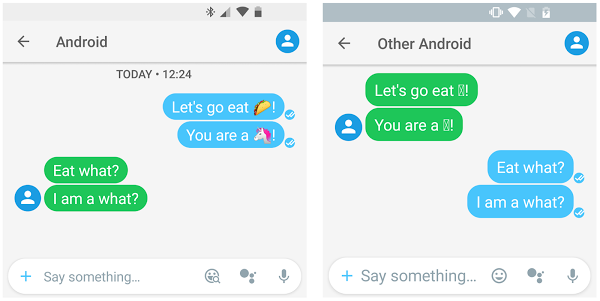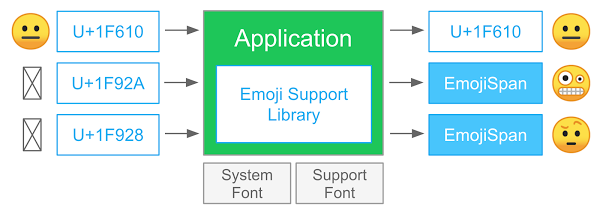The EmojiCompat support library aims to
keep Android devices up to date with the latest emoji. It prevents your app
from showing missing emoji characters in the form of ☐, which
indicates that your device does not have a font to display the text. By
using the EmojiCompat support library,
your app users do not need to wait for Android OS updates to get the latest
emoji.

Refer to the following related resources:
How does EmojiCompat work?
The EmojiCompat support library provides
classes to implement backward-compatible emoji support on devices running
Android 4.4 (API level 19) and higher. You can configure
EmojiCompat with either bundled or
downloadable fonts. For more information about configuration, refer to the
following sections:
EmojiCompat identifies emoji for a given
CharSequence, replaces them with
EmojiSpans, if required, and
finally renders the emoji glyphs. Figure 2 demonstrates the process.

Downloadable fonts configuration
The downloadable fonts configuration uses the Downloadable Fonts support
library feature to download an emoji font. It also updates the necessary
emoji metadata that the EmojiCompat
support library needs to keep up with the latest versions of the Unicode
specification.
Adding support library dependency
To use the EmojiCompat support library,
you must modify your app project's classpath dependencies within your
development environment.
To add a support library to your application project:
- Open the
build.gradlefile of your application. - Add the support library to the
dependenciessection.
Groovy
dependencies { ... implementation "androidx.emoji:emoji:28.0.0" }
Kotlin
dependencies { ... implementation("androidx.emoji:emoji:28.0.0") }
Initializing the downloadable font configuration
You need to initialize EmojiCompat to
load the metadata and the typeface. Since initialization can take some time,
the initialization process runs on a background thread.
To initialize EmojiCompat with the
downloadable font configuration, perform the following steps:
- Create an instance of the
FontRequestclass and provide the font provider authority, the font provider package, the font query, and a list of sets of hashes for the certificate. For more information aboutFontRequest, refer to the Using Downloadable Fonts programmatically section in the Downloadable Fonts documentation. - Create an instance of
FontRequestEmojiCompatConfigand provide instances ofContextandFontRequest. - Initialize
EmojiCompatby calling theinit()method and pass the instance ofFontRequestEmojiCompatConfig. - Use
EmojiCompatwidgets in layout XMLs. If you are usingAppCompat, refer to the Using EmojiCompat widgets with AppCompat section.
Kotlin
class MyApplication : Application() { override fun onCreate() { super.onCreate() val fontRequest = FontRequest( "com.example.fontprovider", "com.example", "emoji compat Font Query", CERTIFICATES ) val config = FontRequestEmojiCompatConfig(this, fontRequest) EmojiCompat.init(config) } }
Java
public class MyApplication extends Application { @Override public void onCreate() { super.onCreate(); FontRequest fontRequest = new FontRequest( "com.example.fontprovider", "com.example", "emoji compat Font Query", CERTIFICATES); EmojiCompat.Config config = new FontRequestEmojiCompatConfig(this, fontRequest); EmojiCompat.init(config); } }
<android.support.text.emoji.widget.EmojiTextView android:layout_width="wrap_content" android:layout_height="wrap_content"/> <android.support.text.emoji.widget.EmojiEditText android:layout_width="wrap_content" android:layout_height="wrap_content"/> <android.support.text.emoji.widget.EmojiButton android:layout_width="wrap_content" android:layout_height="wrap_content"/>
For more information about how to configure
EmojiCompat with the downloadable font
configuration, go to Emoji Compatibility sample app
Java
| Kotlin.
Library components

- Widgets:
EmojiEditText,EmojiTextView,EmojiButton - Default widget implementations to use
EmojiCompatwithTextView,EditText, andButton. EmojiCompat- Main public surface for the support library. It performs all the external calls and coordinates with the other parts of the system.
EmojiCompat.Config- Configures the singleton instance to be created.
EmojiSpan- A
ReplacementSpansubclass that replaces the character (sequences) and renders the glyph. EmojiCompatFontEmojiCompatuses a font to display emoji. This font is a modified version of the Android Emoji font. The font is modified as follows:- To provide backward compatibility to render emoji, all emoji characters are represented with a single Unicode code point in Unicode’s Supplemental Private Use Area-A starting with U+F0001.
-
Extra emoji metadata is inserted in a binary format into the font and
is parsed at runtime by
EmojiCompat. The data is embedded in the font’smetatable, with the private tag Emji.
Configuration options
You can use the EmojiCompat instance to
modify EmojiCompat behavior. You can use
the following methods from the base class to set the configuration:
setReplaceAll(): Determines whetherEmojiCompatshould replace all emoji it finds withEmojiSpans. By default,EmojiCompattries its best to understand if the system can render an emoji and does not replace those emoji. When set totrue,EmojiCompatreplaces all emoji it finds withEmojiSpans.setEmojiSpanIndicatorEnabled(): Indicates whetherEmojiCompathas replaced an emoji with anEmojiSpan. When set totrue,EmojiCompatdraws a background for theEmojiSpan. This method is mainly used for debugging purposes.setEmojiSpanIndicatorColor(): Sets the color to indicate anEmojiSpan. The default value isGREEN.registerInitCallback: Informs app about the state of theEmojiCompatinitialization.
Kotlin
val config = FontRequestEmojiCompatConfig(...) .setReplaceAll(true) .setEmojiSpanIndicatorEnabled(true) .setEmojiSpanIndicatorColor(Color.GREEN) .registerInitCallback(object: EmojiCompat.InitCallback() { ... })
Java
EmojiCompat.Config config = new FontRequestEmojiCompatConfig(...) .setReplaceAll(true) .setEmojiSpanIndicatorEnabled(true) .setEmojiSpanIndicatorColor(Color.GREEN) .registerInitCallback(new InitCallback() {...})
Adding initialization listeners
EmojiCompat and
EmojiCompat classes
provide
registerInitCallback()
and
unregisterInitCallback()
methods to register an initialization callback. To use these methods, create
an instance of the
EmojiCompat.InitCallback class. Call
these methods and pass the instance of the
EmojiCompat.InitCallback class. When the
initialization of the EmojiCompat support
library is successful, the EmojiCompat
class calls the
onInitialized()
method. If the library
fails to initialize, the EmojiCompat
class calls the
onFailed()
method.
To check the initialization state at any point, call the
getLoadState()
method. It returns one of the following values:
LOAD_STATE_LOADING,
LOAD_STATE_SUCCEEDED,
or LOAD_STATE_FAILED.
Using EmojiCompat with AppCompat widgets
If you are using AppCompat widgets, you
can use EmojiCompat widgets that extend
from AppCompat widgets.
- Add the support library to the dependencies section.
Groovy
dependencies { ... implementation "androidx.emoji:emoji-bundled:$version" }
Kotlin
dependencies { implementation("androidx.emoji:emoji-appcompat:$version") }
Groovy
dependencies { implementation "androidx.emoji:emoji-appcompat:$version" }
- Use
EmojiCompatAppCompat Widgetwidgets in layout XMLs.<android.support.text.emoji.widget.EmojiAppCompatTextView android:layout_width="wrap_content" android:layout_height="wrap_content"/> <android.support.text.emoji.widget.EmojiAppCompatEditText android:layout_width="wrap_content" android:layout_height="wrap_content"/> <android.support.text.emoji.widget.EmojiAppCompatButton android:layout_width="wrap_content" android:layout_height="wrap_content"/>
Bundled fonts configuration
The
EmojiCompatsupport library is also available in a bundled font version. This package includes the font with the embedded metadata. The package also includes aBundledEmojiCompatConfigthat uses theAssetManagerto load the metadata and fonts.Note: The size of the font is in multiple megabytes.
Adding support library dependency
To use the
EmojiCompatsupport library with bundled font configuration, you must modify your app project's classpath dependencies within your development environment.To add a support library to your application project:
- Open the
build.gradlefile of your application. - Add the support library to the
dependenciessection.
Groovy
dependencies { ... implementation "androidx.emoji:emoji:28.0.0" }
Kotlin
dependencies { ... implementation("androidx.emoji:emoji:28.0.0") }
Using bundled fonts to configure EmojiCompat
To use bundled fonts to configure
EmojiCompat, perform the following steps:- Use
BundledEmojiCompatConfigto create an instance ofEmojiCompatand provide an instance ofContext. - Call the
init()method to initializeEmojiCompatand pass the instance ofBundledEmojiCompatConfig.
Kotlin
class MyApplication : Application() { override fun onCreate() { super.onCreate() val config = BundledEmojiCompatConfig(this) EmojiCompat.init(config) } }
Java
public class MyApplication extends Application { @Override public void onCreate() { super.onCreate(); EmojiCompat.Config config = new BundledEmojiCompatConfig(this); EmojiCompat.init(config); ... } }
Using EmojiCompat without widgets
EmojiCompatusesEmojiSpanto render correct images. Therefore, it has to convert any givenCharSequenceintoSpannedinstances withEmojiSpans. TheEmojiCompatclass provides a method to convertCharSequencesintoSpannedinstances withEmojiSpans. Using this method, you can process and cache the processed instances instead of the raw string, which improves the performance of your application.Kotlin
val processed = EmojiCompat.get().process("neutral face \uD83D\uDE10")
Java
CharSequence processed = EmojiCompat.get().process("neutral face \uD83D\uDE10");
Using EmojiCompat for IMEs
Using the
EmojiCompatsupport library, keyboards can render the emoji supported by the application they are interacting with. IMEs can use thehasEmojiGlyph()method to check ifEmojiCompatis capable of rendering an emoji. This method takes aCharSequenceof an emoji and returnstrueifEmojiCompatcan detect and render the emoji.The keyboard can also check the version of the
EmojiCompatsupport library that the app supports to determine which emoji to render in the palette. To check the version, if available, the keyboard needs to check whether the following keys exist in theEditorInfo.extrasbundle:EDITOR_INFO_METAVERSION_KEYEDITOR_INFO_REPLACE_ALL_KEY
If the key exists in the bundle, the value represents the version of the emoji metadata that the app uses. If this key does not exist, the app is not using
EmojiCompat.If the key exists and is set to
true, this indicates that the app has called theSetReplaceAll()method. For more information aboutEmojiCompatconfiguration, refer to the Configuration options section.After receiving the keys in the
EditorInfo.extrasbundle, the keyboard can use thehasEmojiGlyph()method, wheremetadataVersionis the value forEDITOR_INFO_METAVERSION_KEY, to check whether the app can render a specific emoji.Using EmojiCompat with custom widgets
You can always use the
process()method to preprocess theCharSequencein your app and add it to any widget that can renderSpannedinstances; for example,TextView. In addition,EmojiCompatprovides the following widget helper classes to let you enrich your custom widgets with emoji support with minimum effort.- Sample TextView
- Sample EditText
Kotlin
class MyTextView(context: Context) : AppCompatTextView(context) { private val emojiTextViewHelper: EmojiTextViewHelper by lazy(LazyThreadSafetyMode.NONE) { EmojiTextViewHelper(this).apply { updateTransformationMethod() } } override fun setFilters(filters: Array<InputFilter>) { super.setFilters(emojiTextViewHelper.getFilters(filters)) } override fun setAllCaps(allCaps: Boolean) { super.setAllCaps(allCaps) emojiTextViewHelper.setAllCaps(allCaps) } }
Java
public class MyTextView extends AppCompatTextView { ... public MyTextView(Context context) { super(context); init(); } ... private void init() { getEmojiTextViewHelper().updateTransformationMethod(); } @Override public void setFilters(InputFilter[] filters) { super.setFilters(getEmojiTextViewHelper().getFilters(filters)); } @Override public void setAllCaps(boolean allCaps) { super.setAllCaps(allCaps); getEmojiTextViewHelper().setAllCaps(allCaps); } private EmojiTextViewHelper getEmojiTextViewHelper() { ... } }
Kotlin
class MyEditText(context: Context) : AppCompatEditText(context) { private val emojiEditTextHelper: EmojiEditTextHelper by lazy(LazyThreadSafetyMode.NONE) { EmojiEditTextHelper(this).also { super.setKeyListener(it.getKeyListener(keyListener)) } } override fun setKeyListener(input: KeyListener?) { input?.also { super.setKeyListener(emojiEditTextHelper.getKeyListener(it)) } } override fun onCreateInputConnection(outAttrs: EditorInfo): InputConnection { val inputConnection: InputConnection = super.onCreateInputConnection(outAttrs) return emojiEditTextHelper.onCreateInputConnection( inputConnection, outAttrs ) as InputConnection } }
Java
public class MyEditText extends AppCompatEditText { ... public MyEditText(Context context) { super(context); init(); } ... private void init() { super.setKeyListener(getEmojiEditTextHelper().getKeyListener(getKeyListener())); } @Override public void setKeyListener(android.text.method.KeyListener keyListener) { super.setKeyListener(getEmojiEditTextHelper().getKeyListener(keyListener)); } @Override public InputConnection onCreateInputConnection(EditorInfo outAttrs) { InputConnection inputConnection = super.onCreateInputConnection(outAttrs); return getEmojiEditTextHelper().onCreateInputConnection(inputConnection, outAttrs); } private EmojiEditTextHelper getEmojiEditTextHelper() { ... } }
Frequently asked questions
- How do I initiate the font download?
- How much time does it take to initialize?
- How much memory does the EmojiCompat support library use?
- Can I use EmojiCompat for a custom TextView?
- What happens if I add widgets in layout XMLs on devices that run on Android 4.4 (API level 19) or lower?
The emoji fonts are downloaded on first request, if they do not exist on the device. The download scheduling is transparent to the app.
After the font is downloaded, it takes approximately 150 milliseconds to initialize
EmojiCompat.Currently, the data structure to find the emoji is loaded in the app’s memory and uses around 200KB.
Yes. EmojiCompat provides helper classes for custom widgets. It is also possible to preprocess a given string and convert it to
Spanned. For more information about widget helper classes, refer to the Using EmojiCompat with custom widgets section.You can include the
EmojiCompatsupport library or its widgets in your applications that support devices running Android 4.4 (API level 19) or lower. However, if a device runs on an Android version prior to API level 19,EmojiCompatand its widgets are in a "no operation" state. This means thatEmojiTextViewbehaves exactly like a regularTextView.EmojiCompatinstance; it immediately gets into aLOAD_STATE_SUCCEEDEDstate when you call theinit()method.Additional resources
For additional information on using the
EmojiCompatlibrary, watch EmojiCompat.Content and code samples on this page are subject to the licenses described in the Content License. Java and OpenJDK are trademarks or registered trademarks of Oracle and/or its affiliates.
Last updated 2025-12-17 UTC.
[[["Easy to understand","easyToUnderstand","thumb-up"],["Solved my problem","solvedMyProblem","thumb-up"],["Other","otherUp","thumb-up"]],[["Missing the information I need","missingTheInformationINeed","thumb-down"],["Too complicated / too many steps","tooComplicatedTooManySteps","thumb-down"],["Out of date","outOfDate","thumb-down"],["Samples / code issue","samplesCodeIssue","thumb-down"],["Other","otherDown","thumb-down"]],["Last updated 2025-12-17 UTC."],[],[]] - Use

